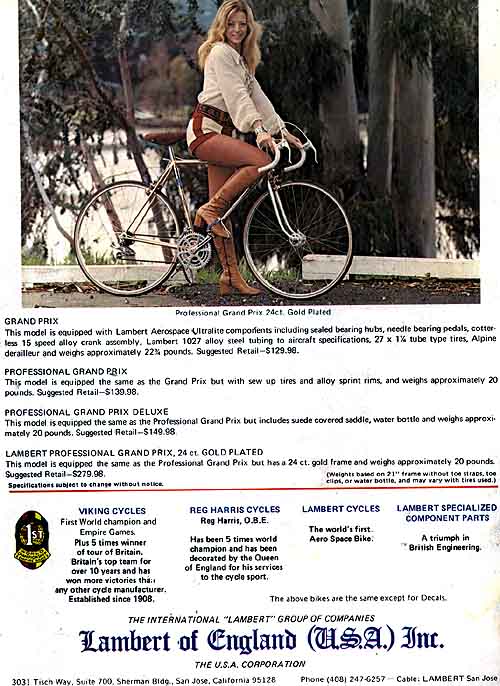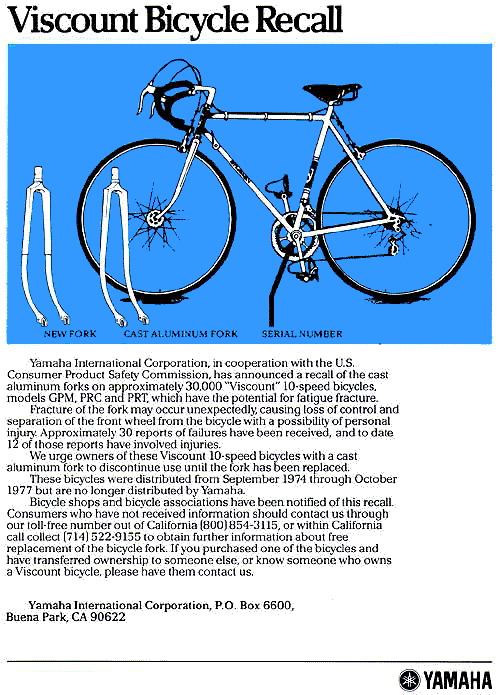Lambert and Viscount Bicycles
The "∆rospace" Frame
|
In the 1970's an English "śrospace" company built, under the names
"Lambert" and "Viscount", surprisingly inexpensive, very lightweight
bikes made with "śrospace" tubing. Now, that, in itself is not as
impressive as it might sound since the aerospace industry specs a
pretty wide variety of steel tubes for different applications. The tubing used was straight-gauge chrome-moly steel; the Viscount version of the bike had a detailed sticker on the seat tube detailing the type of tubes used, throwing in a few references to military specs, etc. Lambert Bicycles were later called "Viscounts" after the company was purchased by Trusty in 1975 or 1976. After being imported to the United States, Viscounts made quite a splash in the bike-oriented magazines and were favorably reviewed. The light-gauge steel tubing made for a 3.75 lb frame (56 cm) and the total bike was claimed to weigh in at between 19 and 21 lbs, depending on whether it was the clincher or tubular model.Most Lamberts were fillet brazed from lightweight straight-gauge chrome-moly tubing, which was decent enough but prone to cracking at the seat tube/bottom bracket juncture. The rear dropouts, which were horizontal, wer models in the first production frames but were downgraded to an unbranded (and softer) version in later models. |
The "Death Fork"
|
The bikes (both Lamberts and Viscounts) came with a cast aluminum fork which was pinned to a steel
steerer
tube. Early production didn't even have the pin. This fork was the main
problem as it had a tendency to snap off the steerer tube with
predictably unfortunate consequences to the rider. UNDER NO CIRCUMSTANCES SHOULD A LAMBERT OR VISCOUNT BE RIDDEN WITH THE ORIGINAL CAST ALUMINUM FORK!!!!!!!!! Having said that, I ignorantly rode my Viscount with the original fork for 5 or so years including many 40-45 mph descents in New Jersey and Washington State for most of those years. The patron saints were working overtime for me!Yamaha purchased the Viscount in 1978 or so and promptly recalled every cast aluminum fork ever sold on a Viscount or Lambert, replacing them with a chromed steel Tange fork. |
Strange Parts
|
There were some other oddities, such as press-fit cartridge bearing bottom brackets (the
spindles
have a tendency to snap at the circlip groove), and what appeared to be
a TA pattern crankset with a Lambert/Viscount-specific large chainring (an aluminum plate with large round holes cut out of it; distinctive and quite attractive in a way). It was unusual to find
cotterless cranks
on bikes in this price range at the time. Most of them, unfortunately,
used a badly designed crank/axle fitting with a non-tapered square
fitting, rather than the normal tapered square. The Viscount version came with a Shimano Crane rear derailleur and Titlist front derailleur, anonymous bars, and Viscount-branded stem, 26.8 mm seatpost, a leather saddle and Viscount-branded centerpull brakes which were either GB or GB knockoffs. It was available in a 27" clincher version (IRC 27 x 1 1/8 tires on Weinmann rims) or a 700C tubular version. There was also a model with steel rims. All models used large flange hubs which appeared to be Normandy copies.As was the fashion in the '70's, there were no braze-ons on these bikes. Water bottle cages, brake cables, derailleur cables, etc. were all held on with clips and clamps. All in all, the Lambert/Viscount bikes were a very interesting chapter of cycling history. In it's original condition it should be a display bike. If it's going to be ridden the aluminum fork must be replaced for safety's sake. Replacing the bottom bracket spindle would be a good idea for a bike that will be ridden regularly, although the unthreaded BB could pose a problem. |
June, 1973
|
|---|
October, 1981 |
| Lambert ... An elaborately advertised and promoted brand name introduction was made in 1972. The USA directed portion of the enterprise was reputed to be well-financed by a member of the Marriott family (hotels, airline catering, etc.) The bikes were an incredible value in their time - the standard model Super Sports sold for $124.95 which featured the same frame as the more expensive models, that being of a seamless "aircraft" tubing. The next model Professional Grand Prix was $134.95, sharing features with the base model except with having "sew up" tires & wheels rather than the 27" clinchers. The gold plated top model Professional Grand Prix 24 ct was with the addition of "Genuine" gold plating. It sold for $259.95! I couldn't say how many of the gold model really existed.... it may have been just an advertising gimmick. It was also understood that the frames were originally made by the old Viking factory in south London. The first batch were lugged frames and quite nicely made. Later they became filet brazed (i.e. lugless.) The Lambert components were all pretty special. The company really went way out on a limb, rather than buying all the various pieces from the normal sub-suppliers, they made or had made for them, parts of their own design and markings. No bicycle manufacturer had made grand attempt in the post war cycling scene except possibly the huge Raleigh Company, and in that case not with the sporting emphasis as in Lambert's case. These special parts included sealed hubs, sealed bottom bracket (although the first batches had conventional cup & cone bearings), crank sets, front and rear derailleur, brakes and brake levers, handlebar and stem, seat posts, sealed bearing pedals and a special cast aluminum front fork (A.K.A. the "Death Fork"!) The headsets, rims, chain and tires were the only off-the-shelf items! Alas, all the Lambert labeled components were not top grade, but also not so bad either, considering the era & the newness of the designs! The problem areas were as follows:
After a few years, Lambert became insolvent and thereafter became "Viscount" cycles, which in turn became heavily invested by the Yamaha Motorcycle Co. A new burst of life arose for the
marquee, but rapidly all the special parts went away and "normal" pieces appeared, i.e. Suntour and Shimano derailleurs, etc. Then the frames became Japanese and Taiwanese (which wasn't too cool in those days) Yamaha finally de alone (the Trusty Co. had in fact been the behind-the-scenes manufacturer for some time)" and staggered on for a year or so before disappearing forever! |